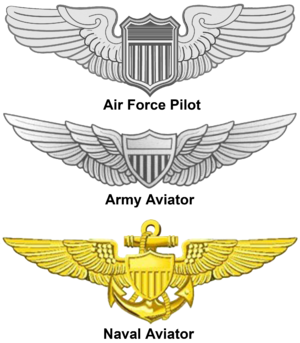- United States Aviator Badge
-
United States Aviator Badge 
Awarded by United States Armed Forces Type Badge Status Currently awarded Statistics Established Second World War First awarded Second World War Last awarded On going Army Precedence Next (higher) (Group 2 badges)
CMB - EFMBEquivalent (Group 3 badges)
Astronaut - EOD - Aviator - Flight Surgeon - AircrewNext (lower) (Group 4 badges)
Parachutist, Air Assault, Military Freefall ParachutistA United States Aviator Badge refers to three types of aviation badges issued by the United States military, those being for Army, Air Force, and Naval aviation.
In the modern military, Army and Air Force Aviator Badges are issued in three ratings: Basic, Senior, and Command/Master/Chief. The higher degrees are denoted by a star or star with wreath above the badge. Air Force regulations state that the basic rating denotes completion of specified training and that the advanced ratings denote experience levels. The Naval Aviator Badge is issued in a single rating for the Navy, Marine Corps, and Coast Guard.
Contents
United States Army
World War I
The first United States Aviator Badges were issued to members of the Air Service during World War I. The badges were issued in three degrees: Observer (a "US" shield and one left-side wing), Junior Aviator or Reserve Aviation Officer (a "US" shield between two wings), and Senior Aviator (a star over "US" shield between two wings). The Army Air Corps also issued a badge for balloon pilots, known as the Aeronaut Badge.
Enlisted Aviators wore their regular rank insignia and the Observer's badge. There were 29 enlisted pilots before the American entry into World War I. The second enlisted aviator, William A. Lamkey, got a discharge and flew for Pancho Villa. The remaining enlisted pilots received commissions in 1917. There were 60 enlisted mechanics who were trained as pilots in France during the war, but they were used for ferrying duties and did not fly in combat.[1] The recruiting and training of enlisted Aviators ended in 1933.
World War II
During World War II, with the rise of the Army Air Forces, a second series of aviator badges were issued to include a design that has survived to the modern day. The Army Air Corps Pilot Badge was issued in three degrees, including Pilot, Senior Pilot, and Command Pilot. A polished silver colored version of these badges is currently used as the United States Air Force Pilot Badges.
From August 1941 to November 1942, the Enlisted Aviator program was restarted. Candidates had to be at least 18, possess a high school diploma, and have graduated at the top of their High School class. Graduates were rated as Flight Staff Sergeants or Flight Technical Sergeants and wore the same pilot's wings as officers. They were usually assigned to pilot transport and auxiliary aircraft to free officer pilots to pilot the more prestigeous fighters and bombers. Auxiliary pilots received their own special wings to indicate their status and specialty. In November 1942 all enlisted pilots were promoted to Flight Officer rank and enlisted cadets were graded as Flight Officers or Second Lieutenants depending on merit.
Cold War
After the creation of the Air Force as a separate service in 1947, Army aviation continued to a degree that warranted a new badge for Army Aviators. The result was the creation of the Army Aviator Badge, which is a modified version of the U.S. Air Force Pilot Badge. It comes in three grades: Basic, Senior (7 years service and 1,000 flight hours), and Master (15 years service and 2,000 flight hours[2]. The Aviator and Senior Aviator Badges were approved on 27 July 1950 and the Master Aviator Badge was approved on 12 February 1957.
United States Air Force
In 1947, the US Army Air Corps became its own separate service as the US Air Force. They use the same pilot's badges as the earlier USAAC except they are made of chrome metal or sterling silver rather than the dull alloy wings used by the Army.
The aviator badge currently used in the Navy has remained virtually unchanged since it was first issued on 13 November 1917. The Naval Aviator Badge is earned by all U.S. Navy, Coast Guard, and Marine Corps pilots upon graduation from advanced flight schooling. Naval Aviators' badges are gold in color.
NASA
With the dawn of the Space Age, all of the United States Aviator badges are upgradable to the Astronaut Badge, for those military pilots who become astronauts.
See also
- Badges of the United States Air Force
- Badges of the United States Army
- Badges of the United States Coast Guard
- Badges of the United States Marine Corps
- Badges of the United States Navy
- Aircrew Badge
- Astronaut Badge
- Auxiliary Pilot Badge
- Flight Officer Badge
- Naval Aviator Badge
- Navigator Badge
- Observer Badge
- Military badges of the United States
- Obsolete badges of the United States military
References
Special Skill Group 1 Special Skill Group 2 Special Skill Group 3 Special Skill Group 4 Special Skill Group 5 Marksmanship Identification National Guard and Other Categories:- United States military badges
Wikimedia Foundation. 2010.


